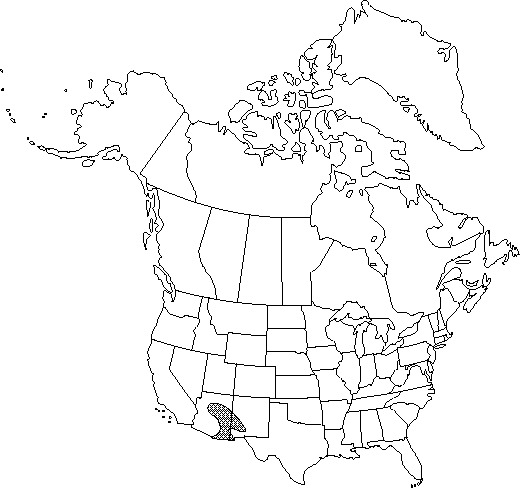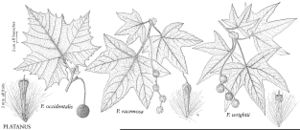Platanus wrightii
Proc. Amer. Acad. Arts 10: 349. 1875.
Trees, to 25 m; trunks straight and erect to inclined or basally reclining or prostrate, to 1.2(-2) m diam., lower branches becoming thick, contorted. Leaves: stipules entire to somewhat dentate. Leaf blade dark green, deeply 3-5(-7)-lobed, 9-25 × 9-30 cm, rather thick; lobes of blade much longer than wide, basal lobes usually smaller and spreading, not reflexed, sinuses broad and very deeply concave, depth of distal sinuses equal or greater than distance from sinus to base of blade, terminal leaf lobe about 2/3 or more length of blade; margins entire to serrulate, apex acute to acuminate; surfaces abaxially and adaxially glabrescent. Pistillate inflorescences: heads (1-)2-4; fruiting heads to 20 mm diam., lateral heads sessile or pedunculate, peduncle often eventually obscured by maturing achenes; fruiting rachis to 25 cm. Achenes 5-8 mm, basal hairs about 2/3 or equal to length of achenes. 2n = 42.
Phenology: Flowering spring; fruiting late fall.
Habitat: Often abundant in riparian forests, especially in montane canyons, extending into deserts along streams and near springs, and cultivated
Elevation: 600-2000+m
Distribution

Ariz., N.Mex., Mexico (Chihuahua, Sinaloa, and Sonora).
Discussion
L. D. Benson (1943) reported intermediates between Platanus wrightii and P. racemosa in southern California. He reduced P. wrightii to P. racemosa var. wrightii (S. Watson) L. Benson. Most authors have retained that taxon at the specific level because of its more deeply lobed, more glabrate leaves and its often pedunculate fruiting heads. Very low yields of germinable seeds were obtained from crosses of P. wrightii and P. racemosa with P. occidentalis (F. S. Santamour Jr. 1972b).
Selected References
None.
